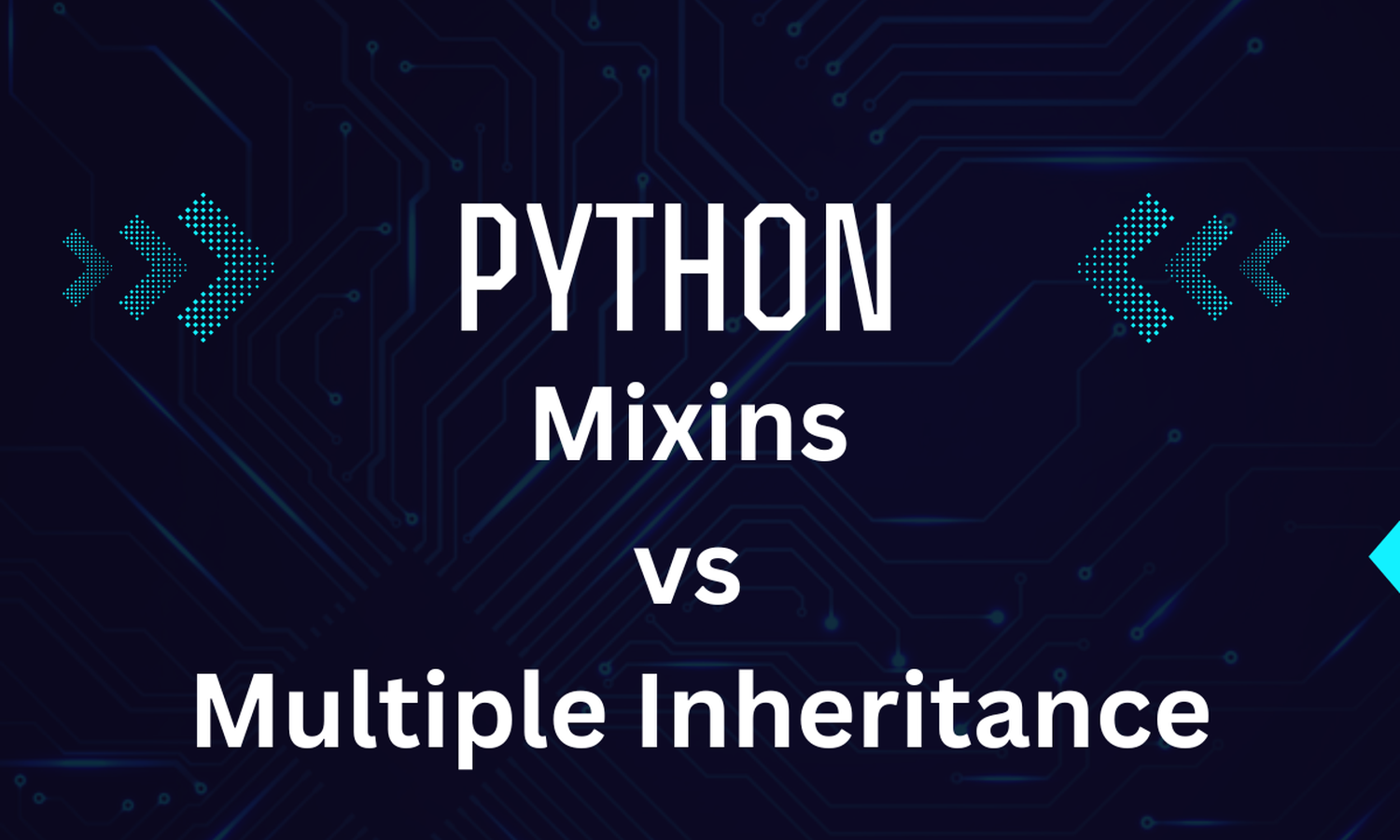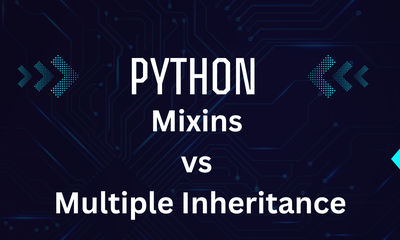Pythonにおける多重継承とミックスインの理解
By JoeVu, at: 2024年8月21日10:10
Estimated Reading Time: __READING_TIME__ minutes


Pythonにおける多重継承とミックスインの理解
オブジェクト指向プログラミング(OOP)は、オブジェクトとクラスを使用してコードをよりモジュール化され、再利用可能な方法で構成するプログラミングパラダイムです。Pythonは、汎用性が高く強力な言語であり、OOPを完全にサポートしているため、開発者は洗練され効率的なアプリケーションを作成できます。
このブログ投稿では、多重継承とミックスインの基礎、その利点と潜在的な落とし穴、および実践的な例について探ります。
OOPのコアコンセプト
多重継承とミックスインに深く掘り下げる前に、いくつかのOOPコアコンセプトを簡単にレビューしましょう。
- クラス: オブジェクトを作成するための設計図です。クラスから作成されたオブジェクトが持つ属性とメソッドのセットを定義します。
- オブジェクト: クラスのインスタンスです。実際の値を持つクラスの具体的な実装です。
例:
class Dog:
def __init__(self, name, age):
self.name = name
self.age = age
def say(self):
print(f"{self.name} can eat!")
my_dog = Dog("Ducky", 3)
my_dog.say() # 出力: Ducky can eat!
多重継承
多重継承とは?
Pythonでは、多重継承により、クラスは複数の基底クラスから継承できます。つまり、派生クラスは、すべての親クラスの属性とメソッドにアクセスできます。これは強力な機能ですが、特に大規模なアプリケーションでは複雑さを招く可能性があります。
これはPHPでは決して起こりません
構文
多重継承の構文は簡単です。カンマで区切って、親クラスを括弧内に列挙するだけです。
class Vehicle:
def __init__(self, make, model):
self.make = make
self.model = model
def drive(self):
return f"{self.make} {self.model} is driving."
class Electric:
def __init__(self, battery_capacity):
self.battery_capacity = battery_capacity
def charge(self):
return f"Charging battery with capacity {self.battery_capacity} kWh."
class ElectricCar(Vehicle, Electric):
def __init__(self, make, model, battery_capacity):
Vehicle.__init__(self, make, model)
Electric.__init__(self, battery_capacity)
# 使用例
my_car = ElectricCar("Tesla", "Model S", 100)
print(my_car.drive()) # Tesla Model S is driving.
print(my_car.charge()) # Charging battery with capacity 100 kWh.
多重継承の例
多重継承をよりよく理解するために、実践的な例を考えてみましょう。
class Person:
def __init__(self, name, age):
self.name = name
self.age = age
def get_details(self):
return f"Name: {self.name}, Age: {self.age}"
class Worker:
def __init__(self, job_title, salary):
self.job_title = job_title
self.salary = salary
def get_job_details(self):
return f"Job Title: {self.job_title}, Salary: {self.salary}"
class Manager(Person, Worker):
def __init__(self, name, age, job_title, salary):
Person.__init__(self, name, age)
Worker.__init__(self, job_title, salary)
def get_full_details(self):
return f"{self.get_details()}, {self.get_job_details()}"
manager = Manager("Alice", 35, "Project Manager", 80000)
print(manager.get_full_details())
出力:
Name: Alice, Age: 35, Job Title: Project Manager, Salary: 80000
多重継承におけるよくある間違い
すべての基底クラスの__init__の呼び出し忘れ: よくある間違いは、すべての親クラスの__init__メソッドの呼び出しを忘れることです。これにより、属性が初期化されない可能性があります。
class A:
def __init__(self):
self.a = "A"
class B:
def __init__(self):
self.b = "B"
class C(A, B):
def __init__(self):
A.__init__(self)
# Bの初期化を忘れました
# B.__init__(self)がありません!
c = C()
print(c.b) # AttributeErrorが発生します: 'C' object has no attribute 'b'
間違ったMRO(メソッド解決順序): メソッド名に注意しないと、予期しないMROのためにPythonが間違ったメソッドを呼び出す可能性があります。これは、基底クラスに同じ名前だが実装が異なるメソッドがある場合に発生する可能性があります。
class A:
def greet(self):
print("Hello from A")
class B(A):
def greet(self):
print("Hello from B")
class C(A):
def greet(self):
print("Hello from C")
class D(B, C):
pass
d = D()
d.greet() # 出力: Hello from B (MROは最初にBを選択します)
ヒント: ClassName.mro()を使用してMROを常に確認し、メソッドが解決される順序を理解してください。
Pythonにおけるミックスイン
ミックスインとは?
ミックスインは、一種の特殊な多重継承です。他のクラスにメソッドを提供するために設計されていますが、それ自体で存在することを意図していません。ミックスインは、モジュール化された方法でクラスに再利用可能な機能を追加するために使用されることがよくあります。従来の継承とは異なり、ミックスインは一般的に小さく、単一の機能に焦点を当てています。
ミックスインの例
ロギング機能を継承する任意のクラスに追加するミックスインクラスを作成しましょう。
class LogMixin:
def log(self, message):
print(f"[LOG]: {message}")
class Person:
def __init__(self, name, age):
self.name = name
self.age = age
def get_details(self):
return f"Name: {self.name}, Age: {self.age}"
class Manager(Person, LogMixin):
def __init__(self, name, age, job_title):
super().__init__(name, age)
self.job_title = job_title
def get_job_details(self):
self.log(f"Getting job details for {self.name}")
return f"Job Title: {self.job_title}"
manager = Manager("Alice", 35, "Project Manager")
print(manager.get_details())
print(manager.get_job_details())
出力:
Name: Alice, Age: 35 [LOG]: Getting job details for Alice Job Title: Project Manager
ミックスインにおけるよくある間違い
ミックスインの誤った使用: ミックスインはスタンドアロンのクラスとして使用すべきではありません。追加の機能を提供するために他のクラスと組み合わせて使用することを目的としています。たとえば、次のコードは混乱やエラーにつながる可能性があります。
class LogMixin:
def log(self, message):
print(f"[LOG]: {message}")
log_mixin = LogMixin()
log_mixin.log("Test message") # これは機能しますが、ミックスインの意図した使用方法ではありません。
ミックスインが多すぎることによる複雑化: 多くのミックスインを継承するクラスを作成し、混乱し複雑な継承階層につながることがあります。常にミックスインを集中してモジュール化してください。
class LogMixin:
pass # 例として
class AuthMixin:
pass # 別の例
class FileManager(LogMixin, AuthMixin):
pass # 多すぎるミックスインを継承すると混乱を招きます。
ヒント: ミックスインは小さく、ロギングや認証など、1つの機能の追加に焦点を当てるべきです。そうすることで、クラス階層が圧倒されるのを防ぎます。
比較: 多重継承 vs. ミックスイン
-
多重継承:
- ユースケース: 機能が異なる複数の基底クラスを組み合わせる必要がある場合。
- 複雑さ: 特にダイヤモンド問題がある場合、複雑で分かりにくいMROにつながる可能性があります。
- 例:
PersonとWorkerを組み合わせてManagerを作成します。
- ユースケース: 機能が異なる複数の基底クラスを組み合わせる必要がある場合。
-
ミックスイン:
- ユースケース: 複雑な階層を作成せずに、複数のクラスに再利用可能な機能を追加したい場合。
- 複雑さ: 多重継承よりもシンプルでモジュール化されています。特定の動作の追加に焦点を当てています。
- 例:
LogMixinを使用して複数のクラスにロギング機能を追加します。
- ユースケース: 複雑な階層を作成せずに、複数のクラスに再利用可能な機能を追加したい場合。
ベストプラクティス
- 再利用可能な機能にはミックスインを使用する: 共通の動作を複数のクラスに追加する必要がある場合は、ミックスインを使用します。
- 多重継承の使用を制限する: 混乱を招く可能性のある複雑な階層を避けてください。
- ミックスインを集中させる: ミックスインは、単一の機能または動作を提供するように設計してください。
- 継承よりも合成を使用する: 多くの場合、合成(他のクラスのインスタンスを使用する)は、継承よりも優れた設計上の選択肢となります。
結論
多重継承とミックスインはPythonの強力なツールであり、柔軟で再利用可能なコードの作成を可能にします。多重継承により、クラスは複数の基底クラスから継承できますが、ミックスインは複雑な階層を作成せずにモジュール化された機能を追加する方法を提供します。違い、よくある間違い、ベストプラクティスを理解することで、これらの機能を活用してPythonプロジェクトを改善できます。
特定の動作の追加にはミックスインを使用し、複雑さを避けるために多重継承の使用を制限してください。常に、コード設計のシンプルさと明瞭さを目指してください。

![[TIPS] Refactoring - Clean Code - Tip 7 - Encapsulate Data and Behavior in Classes](/media/filer_public_thumbnails/filer_public/33/46/334634c4-a8c1-4eda-9e51-38e8df8dc0ef/refactoring_tips_encapsulate_data_and_behavior_in_classes.png__400x240_crop_subsampling-2_upscale.png)
![[TIPs] Python: Compare Tuple and List](/media/filer_public_thumbnails/filer_public/ca/4e/ca4e70d6-3a85-4b47-9067-af7652fdca83/python_tuples_vs_lists.png__400x240_q85_crop_subsampling-2_upscale.jpg)
![[TIPS] Widely-used REGEX](/media/filer_public_thumbnails/filer_public/f4/97/f4979da2-bae0-44e5-808a-d64bb81fd9ce/rgex_applications.png__400x240_crop_subsampling-2_upscale.png)

